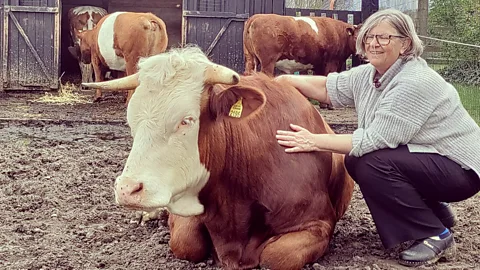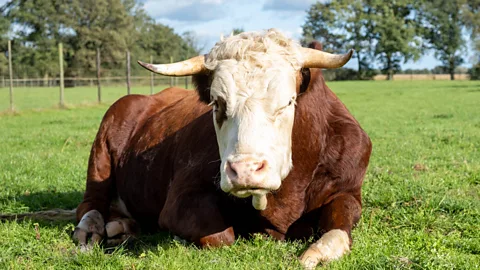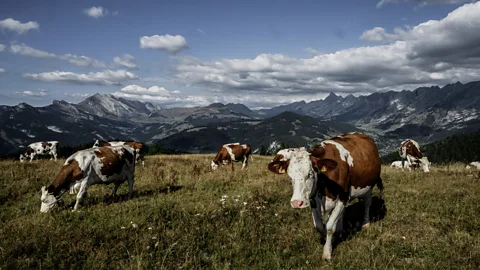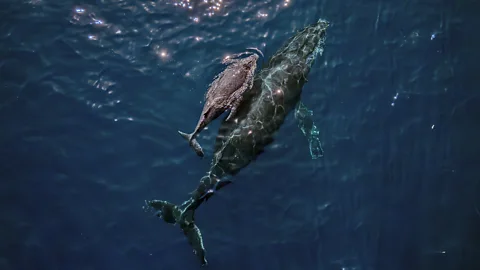Stares and ear-twitches: The linguist learning to speak the expressive language of cows
 Henk van de Ven/Leonie Cornips
Henk van de Ven/Leonie CornipsDutch linguist Leonie Cornips has become fascinated with how cows communicate. But can this really be called 'language'?
Leonie Cornips was long overdue for her coffee break. The chilly autumn air made a hot drink feel enticing. But Cornips was busy. She was a couple of hours into her work with a small herd of dairy cows. If she left now, she would lose something that would take time to recover. Cornips and the herd had entered a delicate, shared space she calls "the rhythm of the cow".
Cornips is a sociolinguist at the Meertens Institute in Amsterdam in the Netherlands. The scholars who pass through the institute's ornate doorway usually specialise in the study of Dutch language and culture. The soft-spoken researcher earned her academic laurels in the 1990s, and she still studies variations in syntax between different dialects in the Netherlands. But in addition to this, Cornips' work has more recently taken what professionals in the field call "the animal turn".
For years, Cornips has spent her summer holidays on a farm. She was struck from the start by the different personalities of individual cows. She read an essay by a philosopher that asked why linguists never study animals. It affected her deeply. Cornips felt that cows had the intelligence and social habits to be good research subjects for a linguist. As a Dutch person, she also knew they were cultural icons in a nation with a passion for cheese. So she turned her professional skills to cows.
 Henk van de Ven/ Leonie Cornips
Henk van de Ven/ Leonie CornipsHumans have assumed for centuries that the ability to use language is a measure of our superiority. There is even an academic term for it: "logocentrism", meaning those who use words (from the Greek logos, meaning "word" or "reason") occupy a privileged position. Language, say many linguists, is what makes us human. Animals may grunt, bark or chirp, but they do not possess anything that counts as language.
Cornips is using her work with dairy cows to push back on this idea. It extends half a century of effort that began with Jane Goodall's work with chimpanzees and Roger Payne's recording of humpback whales in the 1960s in an effort to show that humans may not be as linguistically unique as we had assumed.
Many of Cornips' colleagues were sceptical when she suggested they apply the framework of linguistics to animals.
"The problem is people have no clear idea about language," she says. "When they talk about language, they always refer to what comes out of the mouth." But after spending six years thoroughly immersed in the lives of cows, Cornips thinks that language is better understood as "distributed" between the mouth, body and surroundings, making it embodied, multi-modal and sensory. "I'm eating with the cows, touching, kissing, walking, hugging," she says.
Most research on cow language tend to focus on sounds. A 2015 study in the Netherlands, for example, looked at the pitch of cow sounds to see if they correlated with behaviours and concluded this could be a way to determine their welfare. And a 2019 Australian study found cows not only have distinctive individual vocalisations, but maintain these distinctive calls across a variety of contexts.
Cornips and the farmers she recruits to assist her record the frequency, duration and intensity of the sounds cows make. But she also focusses on the other ways meaning is expressed among bovines. Her methods are often ethnographic, a way of studying cultures that relies strongly on observation by the researcher. Cornips carefully observes cow behaviours and interactions alongside sound to determine how they communicate. "I notice with cows that the body is an instrument to get to know the other," she says. Recognising this leads Cornips to talk less of "language" and more widely of "languaging practices".
Cows, for example, have an elaborate greeting ritual that Cornips must follow to successfully slip into the rhythm of the herd, she says. This became obvious with Piet, a young male Fleckvieh from an intensively managed indoor facility who Cornips brought to join five other cows in an outdoor pasture.
"I was always so happy to see him, that when I got into his meadow, I walked straight towards him and tried to touch him immediately," Cornips says. When she did so, Piet would back away.
Cornips gradually came to understand the need to respect Piet's personal space, as she might with a fellow human. She learned to keep her arms by her sides and only use eye contact intermittently, taking turns with Piet to look at each other and then look away. "It took me quite a while," she says. "I was very stupid. They are teaching me how to connect to them." Cornips realised she had to learn an etiquette. Without patience and attention, she says, you would never see it.
Patience also turns out to be crucial when cows communicate with each other. When a mother calls her calf, it sometimes takes 60 seconds for the calf to respond. The space between is filled with bodily gestures. Studies from Austria show that ear positioning and neck-stretching are integral to cow language. Humans think of the ability to wiggle our ears as a party trick. For a cow, it appears to be fundamental to communication. The first sentence in a conversation with a cow is likely to involve movement of the ears and a look.
Cows are not the only animals being studied for their complex modes of communication. Michelle Fournet, an assistant professor specialising in marine acoustic ecology at the University of New Hampshire in the US, has learned it is unhelpful to impose human expectations on species like whales and seals.
Animals use sound completely differently from how humans use it, she says. "If we are to do a good job at understanding how animals are communicating and why they are communicating, it behoves us to adopt their perspective."
 Getty Images
Getty ImagesFournet stops short of using the word "language" to describe the information transfer taking place between non-humans. But she has gained a deep appreciation for the subtleties of animal communication. Their system is not less than ours, Fournet says, but other. We do them a disservice by searching for similarities.
One difference between humans and many animals is their use of the environment. Cornips has found cow communication leans on its surroundings more than ours. She observed one herd where individuals used their bodies to bang on an iron fence to communicate with the rest of the herd at feeding time, which she views as a type of language. She noticed cows responding to her differently depending on whether she entered a barn with solid walls or open sides: since cows on different farms are surrounded by different physical features, this offers distinctive opportunities for linguistic expression. Cows, she argues, develop diverse languaging practices – almost like dialects – where meaning depends on the shape of their surroundings.
Like other domestic animals, cows face the additional challenge of interspecies communication with humans. "Most farmers are not sensitive to the rhythm of the cow," says Cornips. "The cows must obey the rhythm of the farmer." Dairy herds are constantly shunted between feeding, milking and grazing grounds. If a cow does not learn the daily routine or fails to be productive, it goes to the slaughterhouse. She is shocked by how readily people assume cows are stupid.
"In becoming a dairy cow," she says, "they must have very rich communicative skills because they have to understand what the farmer wants them to do… which is not easy."
Cornips has analysed recordings to show that cows will simplify their vocalisation once a farmer recognises their need. Rather than having their intelligence bred out of them to be more compliant, Cornips thinks domestic animals are forced to develop a fuller communication repertoire than wild animals.
If dairy cows have complex linguistic practices, it's tempting to ask how they stack up against the other great communicators in the animal kingdom. How would they compare, for example, to humpback whales? Cornips admires the complex vocalisations found in whale song. Humpbacks are among the cetaceans known to develop different dialects in different regions. They also communicate over vast distances. (Read more about the sophisticated structures similar to those found in human language which researchers are uncovering in whale communication).
But Cornips points out that whales lack some of the capacities of cows. A whale's ears are not as moveable as a cow's, she says. They also lack hooves. "Whales cannot express themselves bodily very much," Cornips says. "In that way they may be [less complex] than cows."
 Getty Images
Getty ImagesFournet says she does not believe it makes sense to rank animal communication by its complexity. "There isn't an answer to what you are looking for," she told me when I asked her to compare whales to cows.
Many traditional linguists are still hesitant to ascribe language to non-humans. Leora Bar-el, a linguistics professor at the University of Montana in the US, is not hostile to the idea of animal language but thinks it worth asking what we gain and what we lose by expanding the definition of language to include cows.
"We may lose the fact there is something unique about human language," she says. For example, human language permits incredible creativity. Think of the works of Shakespeare. It can also refer to distant events and even reflect back on itself, as language does when it provides a definition.
But Eva Meijer, author of the essay that first inspired Cornips and the 2018 book Animal Languages, argues such claims can be self-fulfilling. "What we see as language has been developed by excluding the language of other animals," she says. In fact, we define language in a way that makes it easy to deny it to others. Meijer points out the long history of human oppression associated with denying other people their language. She believes that recognising language in animals provides new tools for understanding them and perhaps even for learning how to inhabit the planet more sustainably.
Cornips, though, does not put an animal rights agenda at the centre of her work. She is focused primarily on expanding the field of linguistics. But the implications are hard to ignore. Cows may have more complex social lives than we thought. Her research reveals numerous additional avenues for exploration. How much does language contribute to distinctive bovine communities and cultures? What sort of planning can cows do with each other? Can they use language to pass on knowledge between generations?
The answers to these questions could change how we regard the lives of many animals. When 96% of the weight of mammals on earth is made up of humans and domesticated livestock, understanding better what cattle, sheep and chickens are communicating could lead to improved relationships with them, as well as better lives for animals.
Cornips knows things are unlikely to change fast. Recently, though, she has noticed the idea that animals have language has become more common in academic journals.
She hopes linguistics can be a tool for unlocking different attitudes. "My most important goal," she says, "is to show others that you can look with different eyes at a domestic animal."
--
For essential climate news and hopeful developments to your inbox, sign up to the Future Earth newsletter, while The Essential List delivers a handpicked selection of features and insights twice a week.
